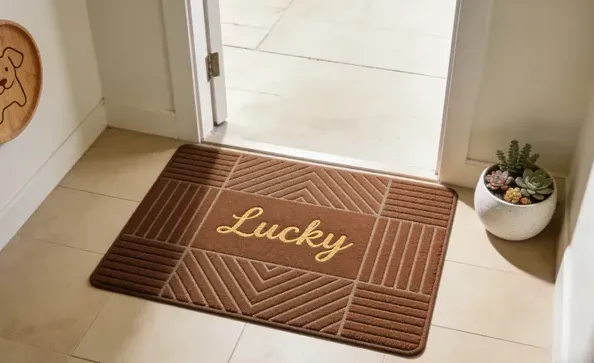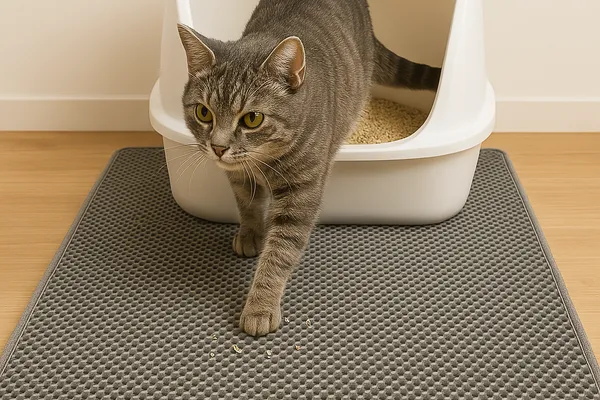I watched my cat scratch up a corner of my couch. It drove me crazy. I needed a solution, fast.
Cat scratch mats are designed to redirect your cat’s scratching behavior. They protect your furniture and provide a healthy outlet for your cat’s natural instincts. They work best when they mimic the textures cats love to scratch, like sisal or cardboard. A well-chosen mat can save your furniture and give your cat something fun and safe to scratch.
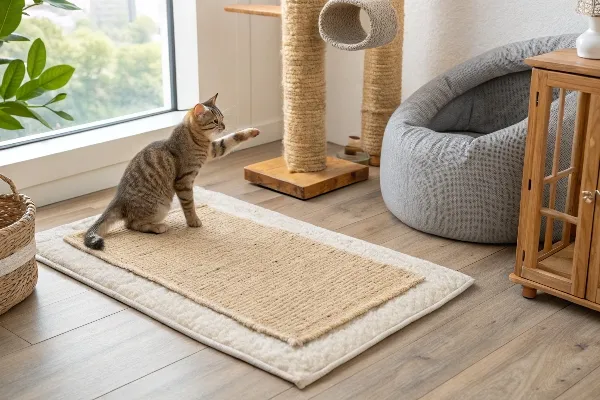
At first, I wasn’t sure if these mats would work. But after trying a few, I noticed that my cat used the mat instead of the sofa. It made a big difference, and I want to share what I learned.
Why do cats love scratch pads?
I was puzzled when my cat scratched everything in sight. It seemed random and frustrating. But then, I learned why they do it.
Cats love scratching pads1 because it’s instinctual. Scratching helps them mark territory, stretch their muscles, and sharpen their claws. It’s a natural behavior that keeps them healthy. Scratching pads allow them to do this safely and without damaging your home.
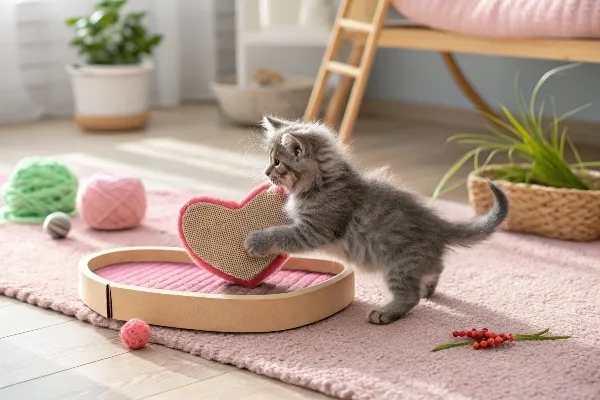
Understanding Why Cats Scratch
I used to get frustrated with my cat’s scratching, thinking it was just a bad habit. But scratching is a vital part of a cat’s life. It’s part of how they communicate with other cats. The scent glands in their paws leave a trace on the objects they scratch. This marks their territory, making them feel secure.
Scratching also helps cats exercise and stretch their muscles. It keeps their claws sharp, which is important for both hunting and self-defense. Without a proper outlet, your cat might scratch furniture, carpets, or walls, causing damage. Providing a designated scratching mat or pad prevents your cat from targeting inappropriate surfaces.
Beyond the physical benefits, scratching is a stress reliever for cats. It gives them something to focus on and provides a routine activity. It’s a way for them to alleviate tension. If a cat doesn’t have a scratching outlet, it might scratch in places you don’t want, leading to frustration for both you and your pet.
Here’s a quick breakdown:
| Reason | Explanation |
|---|---|
| Territory marking | Cats leave their scent to mark their area |
| Muscle stretching | Scratching helps keep their claws and muscles sharp |
| Stress relief | Scratching provides comfort and reduces anxiety |
When I realized how important scratching was for my cat, I focused on giving him the right tools to scratch. This not only saved my furniture but also gave my cat a sense of peace.
What is the best thing for a cat to scratch?
My cat loved the sofa, but I needed a better solution. So, what’s the best thing for a cat to scratch?
The best thing for a cat to scratch is something that feels natural to them, like sisal, cardboard2, or wood. These materials are rough enough to satisfy their scratching needs. A vertical or horizontal scratching surface works best, depending on your cat’s preferences.
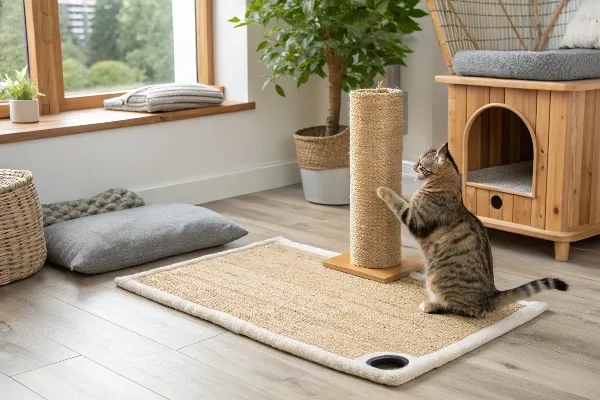
Exploring the Best Materials for Cat Scratching
I tried several different materials before finding what worked best for my cat. Here’s a breakdown of the options:
Sisal
Sisal is one of the best materials for cats to scratch. It has a rough texture that mimics tree bark, which is what cats would scratch in the wild. My cat enjoys scratching sisal posts because it gives him the right resistance. It’s also durable, so it doesn’t wear down quickly. Sisal is commonly used in scratchers because it’s safe, eco-friendly, and satisfies the cat’s instincts.
Cardboard
Cardboard scratchers are another favorite. They have a softer texture compared to sisal but still provide a good surface for scratching. I used a cardboard scratcher for my cat, and it worked well. The material is inexpensive, and cats enjoy it because they can shred it with their claws. It’s also easier to replace, making it a convenient choice.
Wood
Wood scratchers offer a natural option that many cats like. I tried a wooden scratching post once, and my cat found it satisfying. It mimics the bark of trees, which is what cats scratch in the wild. While wood can be a bit pricier than sisal or cardboard, it’s durable and can withstand years of scratching.
Here’s a table comparing the best materials:
| Material | Benefits | Considerations |
|---|---|---|
| Sisal | Durable, rough texture, eco-friendly | Can be expensive for larger posts |
| Cardboard | Soft, easy to replace, affordable | Wears down quicker than sisal |
| Wood | Natural feel, durable | Can be more costly, harder to find |
When choosing a scratching surface, I think about my cat’s habits and the material’s durability. Each material serves a different purpose, and you may need to try a few to find what works best for your cat.
What is the best material for cats scratching?
I wanted something that would last, and I also needed a material that my cat would actually enjoy scratching.
The best materials for cat scratching are sisal, cardboard, and wood. These materials are durable and provide the right texture to satisfy a cat’s scratching needs. The key is to choose a material that aligns with your cat’s preferences and natural instincts.
Material Choices for Lasting Scratching Enjoyment
I noticed that cats have distinct preferences for materials. Some like rough textures, while others prefer softer surfaces. When I chose a scratching mat for my cat, I focused on how well the material could stand up to frequent use. Here’s a deeper dive into the best options:
Sisal
Sisal is by far one of the most durable and scratch-friendly materials. It’s often used in cat scratchers because it’s tough enough to handle repeated scratching without showing wear quickly. I placed a sisal mat on the floor for my cat, and he loved it. The texture closely resembles tree bark, which is exactly what cats would scratch in nature. It’s a great long-term option, especially for cats who love to scratch aggressively.
Cardboard
Cardboard is a great, cost-effective choice. It’s soft and easy to shred, which some cats enjoy. I’ve had success with cardboard scratchers that come in various shapes and sizes. The downside is that cardboard doesn’t last as long as sisal. After a while, it starts to show signs of wear. But it’s an affordable solution, and if your cat is a light scratcher, it could be all they need.
Wood
Wood is a natural material that offers a rustic touch. It’s durable, and many cats love scratching it. My cat enjoyed a wooden post, but the cost was higher compared to sisal or cardboard. However, wood is strong and can withstand years of scratching, making it a good long-term investment. The texture is rough enough to feel satisfying for most cats, and the scent of wood might also attract them.
I keep in mind the longevity and price of each material. A good scratching surface should last for months or even years, depending on how much my cat uses it. I also consider the material’s natural qualities and how close it is to what cats scratch in the wild.
Here’s a quick comparison:
| Material | Durability | Cost |
|---|---|---|
| Sisal | Highly durable, lasts a long time | Higher cost for larger posts |
| Cardboard | Shorter lifespan, but affordable | Very affordable, easy to replace |
| Wood | Long-lasting, strong | Higher cost, natural appearance |
Choosing the right material depends on your budget, your cat’s scratching behavior, and the style of your home. After trying different options, I’ve found that a mix of sisal and cardboard is perfect for my cat.
What type of cat scratcher is best?
I wanted a scratcher that would fit my space and provide my cat with the right outlet.
The best type of cat scratcher3 depends on your cat’s behavior and the space you have. Vertical posts, horizontal mats, or angled scratchers all have their benefits. Vertical scratchers mimic the action of climbing trees, while horizontal ones let cats stretch out.
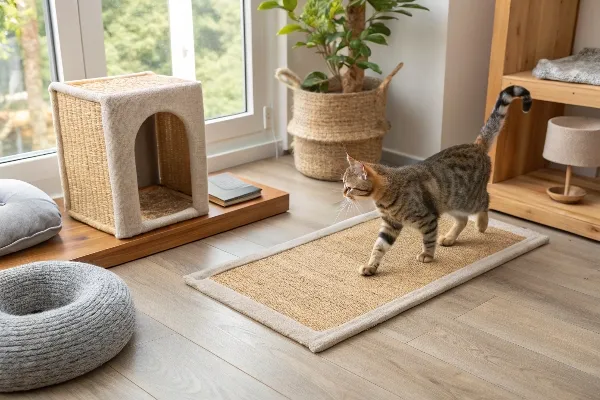
Understanding the Best Type of Cat Scratcher
I spent a lot of time figuring out what scratcher worked best for my cat. Some cats like to scratch vertically, while others prefer to scratch horizontally. I found that it helps to have a variety of scratchers to match their habits.
Vertical Scratchers
Vertical scratchers mimic the action of scratching tree trunks. They let your cat stretch up while maintaining balance. These are ideal for cats who like to climb or stretch in an upright position. I placed a tall sisal post near a window, and my cat loved it. He could stretch, scratch, and watch the birds outside.
Horizontal Scratchers
Horizontal scratchers are great for cats who prefer to lie down while scratching. These mats are easier to place near sleeping areas, like a bed or sofa. I used a cardboard scratching pad for my cat, and it worked well for lounging and scratching. These scratchers are compact and can be moved easily.
Angled Scratchers
Angled scratchers combine elements of both vertical and horizontal scratchers. They provide a slanted surface that allows cats to stretch in various positions. Some angled scratchers even feature dual sides with different materials for variety.
Here’s a quick comparison of scratcher types:
| Type | Best For | Material |
|---|---|---|
| Vertical | Cats who like to stretch upward | Sisal, Wood, or Carpet |
| Horizontal | Cats who prefer to scratch lying down | Cardboard, Carpet |
| Angled | Cats who enjoy multiple scratching positions | Sisal, Carpet, or Cardboard |
When choosing a scratcher, consider your cat’s scratching style and available space. I find that having both vertical and horizontal scratchers helps my cat stay satisfied.
Conclusion
Cat scratch mats work well when chosen carefully. They protect furniture, satisfy scratching instincts, and provide healthy outlets for your cat.
-
Exploring this resource will help you understand the significance of scratching pads in promoting your cat’s health and well-being. ↩
-
Cardboard scratchers are affordable and enjoyable for cats. Discover why they love this material and how it benefits them. ↩
-
Explore this link to discover various cat scratcher types and find the perfect fit for your feline’s needs! ↩

